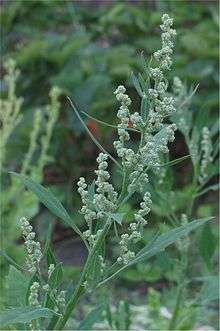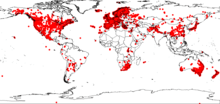Chenopodium album
Chenopodium album is a fast-growing weedy annual plant in the genus Chenopodium. Though cultivated in some regions, the plant is elsewhere considered a weed. Common names include lamb's quarters, melde, goosefoot, manure weed, wild spinach and fat-hen, though the latter two are also applied to other species of the genus Chenopodium, for which reason it is often distinguished as white goosefoot.[2][3][4][5] Chenopodium album is extensively cultivated and consumed in Northern India as a food crop known as bathua.[6][7]
| Chenopodium album | |
|---|---|
 | |
| Scientific classification | |
| Kingdom: | Plantae |
| Clade: | Tracheophytes |
| Clade: | Angiosperms |
| Clade: | Eudicots |
| Order: | Caryophyllales |
| Family: | Amaranthaceae |
| Genus: | Chenopodium |
| Species: | C. album |
| Binomial name | |
| Chenopodium album | |
 | |
| Occurrence download from GBIF[1] | |
Distribution
Its native range is obscure due to extensive cultivation,[8] but includes most of Europe,[9] from where Linnaeus described the species in 1753.[10] Plants native in eastern Asia are included under C. album, but often differ from European specimens.[11] It is widely naturalised elsewhere, e.g. Africa,[12] Australasia,[13] North America,[5] and Oceania,[4] and now occurs almost everywhere (even, apparently in Antarctica)[1] in soils rich in nitrogen, especially on wasteland.
Botany
It tends to grow upright at first, reaching heights of 10–150 cm (rarely to 3 m), but typically becomes recumbent after flowering (due to the weight of the foliage and seeds) unless supported by other plants. The leaves are alternate and varied in appearance. The first leaves, near the base of the plant, are toothed and roughly diamond-shaped, 3–7 cm long and 3–6 cm broad. The leaves on the upper part of the flowering stems are entire and lanceolate-rhomboid, 1–5 cm long and 0.4–2 cm broad; they are waxy-coated, unwettable and mealy in appearance, with a whitish coat on the underside. The small flowers are radially symmetrical and grow in small cymes on a dense branched inflorescence 10–40 cm long.[3][4][5][11] Further, the flowers are bisexual and female, with five tepals which are mealy on outer surface, and shortly united at the base.[14] There are five stamens.[14]
Taxonomy
Chenopodium album has a very complex taxonomy and has been divided in numerous microspecies, subspecies and varieties, but it is difficult to differentiate between them. The following infraspecific taxa are accepted by the Flora Europaea:[9]
- Chenopodium album subsp. album
- Chenopodium album subsp. striatum (Krašan) Murr
- Chenopodium album var. reticulatum (Aellen) Uotila
Published names and synonyms include C. album var. microphyllum, C. album var. stevensii, C. acerifolium, C. centrorubrum, C. giganteum, C. jenissejense, C. lanceolatum, C. pedunculare and C. probstii.
It also hybridises readily with several other Chenopodium species, including C. berlandieri, C. ficifolium, C. opulifolium, C. strictum and C. suecicum.
Cultivation
Regions
The species are cultivated as a grain or vegetable crop (such as in lieu of spinach), as well as animal feed in Asia[6] and Africa, whereas in Europe and North America, it is commonly regarded as a weed in places such as potato fields,[15] while in Australia it is naturalised in all states and regarded as an environmental weed in New South Wales, Victoria, Western Australia and the Northern Territory.[16]
Potential impact on conventional crops
It is one of the more robust and competitive weeds, capable of producing crop losses of up to 13% in corn, 25% in soybeans, and 48% in sugar beets at an average plant distribution. It may be controlled by dark tillage, rotary hoeing, or flaming when the plants are small. Crop rotation of small grains will suppress an infestation. It is easily controlled with a number of pre-emergence herbicides.[17] Its pollen may contribute to hay fever-like allergies.[18]
Pest control
Chenopodium album is vulnerable to leaf miners, making it a useful trap crop as a companion plant. Growing near other plants, it attracts leaf miners which might otherwise have attacked the crop to be protected. It is a host plant for the beet leafhopper, an insect which transmits curly top virus to beet crops.
Uses and consumption
Food
| Nutritional value per 100 g (3.5 oz) | |
|---|---|
| Energy | 180 kJ (43 kcal) |
7.3 g | |
| Dietary fiber | 4 g |
0.8 g | |
4.2 g | |
| Vitamins | Quantity %DV† |
| Vitamin A equiv. | 73% 580 μg |
| Thiamine (B1) | 14% 0.16 mg |
| Riboflavin (B2) | 37% 0.44 mg |
| Niacin (B3) | 8% 1.2 mg |
| Pantothenic acid (B5) | 2% 0.092 mg |
| Vitamin B6 | 21% 0.274 mg |
| Folate (B9) | 8% 30 μg |
| Vitamin C | 96% 80 mg |
| Minerals | Quantity %DV† |
| Calcium | 31% 309 mg |
| Iron | 9% 1.2 mg |
| Magnesium | 10% 34 mg |
| Manganese | 37% 0.782 mg |
| Phosphorus | 10% 72 mg |
| Potassium | 10% 452 mg |
| Sodium | 3% 43 mg |
| Zinc | 5% 0.44 mg |
| |
| †Percentages are roughly approximated using US recommendations for adults. Source: USDA Nutrient Database | |
The leaves and young shoots may be eaten as a leaf vegetable, either steamed in its entirety, or cooked like spinach, but should be eaten in moderation due to high levels of oxalic acid.[19] Each plant produces tens of thousands of black seeds. These are high in protein, vitamin A, calcium, phosphorus, and potassium. Quinoa, a closely related species, is grown specifically for its seeds.[20] The Zuni people cook the young plants' greens.[21] Bathua seeds also double up for rice and dal. Napoleon Bonaparte is said to have once relied on bathua seeds to feed his troops during lean times.
Archaeologists analysing carbonized plant remains found in storage pits and ovens at Iron Age, Viking Age, and Roman sites in Europe have found its seeds mixed with conventional grains and even inside the stomachs of Danish bog bodies.[22]
In India, the plant is called bathua and found abundantly in the winter season.[23] The leaves and young shoots of this plant are used in dishes such as soups, curries, and paratha-stuffed breads, common in North India. The seeds or grains are used in phambra or laafi, gruel-type dishes in Himachal Pradesh, and in mildly alcoholic fermented beverages such as soora and ghanti.[24] In Haryana state, the "bathue ka raita" i.e. the raita (yogurt dip) made with bathua, is very popular in winters.[25]
Animal feed
As some of the common names suggest, it is also used as feed (both the leaves and the seeds) for chickens and other poultry.
Construction
The juice of this plant is a potent ingredient for a mixture of wall plaster, according to the Samarāṅgaṇa Sūtradhāra, which is a Sanskrit treatise dealing with Śilpaśāstra (Hindu science of art and construction).[26]
Ayurveda
In Ayurveda traditional medicine, bathua is thought to be useful for treating various diseases,[27] although there is no clinical evidence such uses are safe or effective.
Gallery
 Close-up of flower and flower bud
Close-up of flower and flower bud Young Chenopodium album
Young Chenopodium album Domestic Lamb's Quarter - Cecil County, MD - November 2015
Domestic Lamb's Quarter - Cecil County, MD - November 2015
References
- Chenopodium album L. GBIF.org (25 November 2018) GBIF Occurrence Download doi:10.15468/dl.ie2d48
- BSBI: Database of names (xls file) Archived 2009-07-07 at the Portuguese Web Archive
- Flora of NW Europe: Chenopodium album
- Pacific Island Ecosystems at Risk: Chenopodium album
- Flora of North America: Chenopodium album
- "Handbook of Herbs Cultivation and Processing", By Niir Board, p. 146
- "Chenopodium album - Bathua". Flowersofindia.net. Retrieved 15 August 2013.
- "Chenopodium album". Germplasm Resources Information Network (GRIN). Agricultural Research Service (ARS), United States Department of Agriculture (USDA). Retrieved 2017-12-15.
- Flora Europaea: Chenopodium album
- Linnaeus, C. (1753). Species Plantarum 1: 219. Facsimile.
- Flora of China: Chenopodium album
- African Flowering Plants Database: Chenopodium album Archived April 27, 2008, at the Wayback Machine
- Australian Plant Name Index: Chenopodium album
- "VicFlora (Flora of Victoria) Chenopodium album". Royal Botanic Gardens Foundation Victora. Retrieved 26 November 2018.
- Grubben, G. J. H., & Denton, O. A. (2004). Plant Resources of Tropical Africa 2. Vegetables. PROTA Foundation, Wageningen; Backhuys, Leiden; CTA, Wageningen.
- "Chenopodium album Weeds of Australia". Biosecurity Queensland Edition, Queensland Government. Retrieved 26 November 2018.
- "University of Florida IAS extension". Edis.ifas.ufl.edu. Retrieved 15 August 2013.
- Amini, A.; Sankian, M.; Assarehzedegan, M.A.; Vahedi, F.; Varasteh, A. (April 2011). "Chenopodium album pollen profilin (Che a 2): homology modeling and evaluation of cross-reactivity with allergenic profilins based on predicted potential IgE epitopes and IgE reactivity analysis". Molecular Biology Reports. 38 (4): 2578–87. doi:10.1007/s11033-010-0398-2. PMID 21086179.
- Johnson, Derek; Kershaw, Linda; MacKinnon, Andy; Pojar, Jim (1995). Plants of the Western Boreal Forest and Aspen Parkland. Lone Pine Publishing. ISBN 978-1-55105-058-4.
- PROTAbase: Chenopodium album Archived August 4, 2007, at the Wayback Machine
- Castetter, Edward F. 1935 Ethnobiological Studies in the American Southwest I. Uncultivated Native Plants Used as Sources of Food. University of New Mexico Bulletin 4(1):1-44 (p. 16)
- Miles, David (1978). An introduction to Archaeology. Great Britain: Ward Lock. p. 99. ISBN 978-0-7063-5725-7.
- "Bathua (cheel Bhaji) Glossary | Recipes with Bathua (cheel Bhaji)". Tarladalal.com. Retrieved 2013-08-15.
- The himalayan grain chenopods. I. Distribution and ethnobotany
- Bathua ka Raita | Haryana bathua recipe | Indian cuisine, masterchefu.com.
- Nardi, Isabella (2007). The Theory of Citrasutras in Indian Painting. Routledge. p. 121. ISBN 978-1134165230.
- L. D. Kapoor, 1989, CRC Handbook of Ayurvedic Medicinal Plants, CRC Press, Boston, pp. 113.
External links

